| |
IDENTIFYING THE “PEOPLE”
Who were these rioters or protestors? The visual record of The Tokyo Riot Graphic not only confirms what we learn from other sources. In two important ways relating to class and to gender, it extends our understanding. Arrest and trial records show the participants, or at least those targeted by the police and the prosecutor, to be quite diverse in occupation and social class.
|
|
| |
Occupations of People Arrested or
tried in Tokyo Riots, 1905–18
|
|
| |
Occupation: |
Incidents,
1905 &
Sept. 1906: |
Incidents,
Feb 1913 &
Feb 1914: |
Incidents,
1918: |
In 1908 occupational census: |
|
|
|
| |
Merchant/tradesman |
91 (28%) |
64 (30%) |
60 (24%) |
(41%)
|
|
| |
Artisan |
82 (25%) |
27 (13%) |
22 (9%) |
(7%)
|
|
| |
Outdoor labor/
building trades |
28 (9%) |
13 (6%) |
47 (19%) |
(6%)
|
|
| |
Transport/rickshaw |
29 (9%) |
10 (5%) |
7 (3%) |
(11%)
|
|
| |
Factory labor |
44 (14%) |
16 (8%) |
53 (21%) |
(14%)
|
|
| |
Student |
10 (3%) |
41 (19%) |
10 (4%) |
|
|
| |
Professional/white collar |
13 (4%) |
8 (4%) |
28 (11%) |
(12%)
|
|
| |
Unemployed |
20 (6%) |
7 (3%) |
13 (5%) |
(1%)
|
|
| |
Other |
10 (3%) |
7 (3%) |
13 (5%) |
(10%)
|
|
| |
Totals: |
327 |
214 |
249 |
712,215
|
|
|
| |
Source: Andrew Gordon, Labor and Imperial Democracy in Prewar Japan (Berkeley:
University of California Press, 1991)
The only social group significantly under-represented relative to the city’s population among those arrested was the professional class of bureaucrats, doctors, lawyers, journalists, and managers, a category which encompasses the very people who organized the gatherings that ended in riot. Wage labor, broadly defined, was a major element in the crowd, with artisans a leading component in the 1905 (and again in 1906) riots, and factory labor more prominent by 1918. All told, the class composition of the crowd—at least of those arrested—was heterogeneous. Participants came from a broad range of lower- and some middle-class urbanites: masters, artisans, and apprentices, shopkeepers and their employees, factory workers, outdoor laborers, transport workers, and students.
We see this variety confirmed in photos and illustrations from The Tokyo Riot Graphic. In the vicinity of the park on the day of the rally, the camera captured people ranging from gentlemen in relatively formal Japanese dress, a few in Western dress, and working class men in the traditional happi coat. These jackets were decorated with characters indicating an employer or sponsor and worn by rickshaw pullers and day laborers among others.
|
|
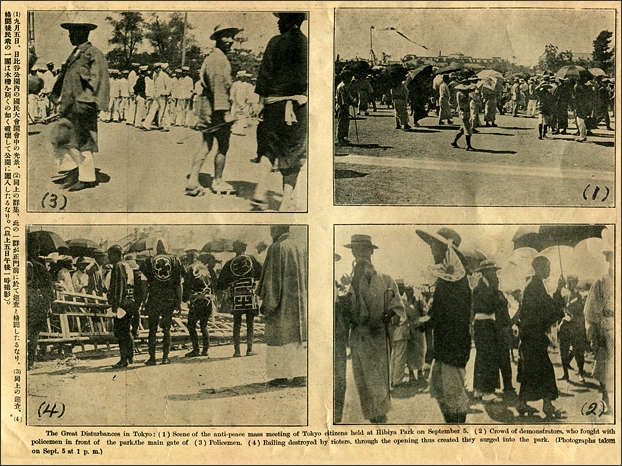 |
| |
Crowds at the September 5 protests came from a broad range
of workers and middle-class urbanites.
English caption: “The Great Disturbances in Tokyo: (1) Scene of the anti-peace mass meeting of Tokyo citizens held at Hibiya Park on September 5. (2) Crowd of demonstrators, who fought with policemen in front of [the main gate of] the park. (3) Policemen. (4) Railing destroyed by rioters, through the opening thus created they surged into the park. (Photographs taken on Sept. 5 at 1 p.m.)”
[trg005]
|
|
| |
The arrest records for the 1905 riot included only a few men identified as “office worker” (10 of 273, about four percent). This suggests that men of substance and status, although they led the organizations which called for rallies and spoke at those rallies, did not take major part in the violence which followed. The visual record suggests this was not necessarily the case. It gives relative prominence to men of professional, Westernized appearance. An illustration showing a crowd attacking the offices of the Tokyo Street Railway Company, for example, depicts men in Western dress, including a man in a jacket and necktie in the middle ground who appears to be urging on the crowd.
|
|
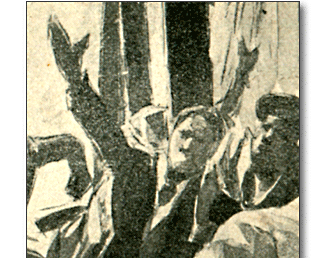 |

Rioters attack the office of the Tokyo Street Railway Company.
English caption: “The Great Disturbances in Tokyo: The picture represents the disorderly scene which was seen at the extensive space at the north-eastern corner of Hibiya Park. The burning building is a branch office of the Tokyo Street Railway Co.”
[trg017] |
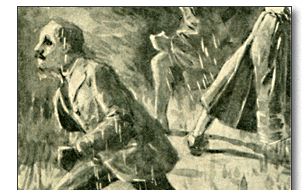 |
 
Another illustration, showing crowds leaping from a stone wall to escape the police, likewise includes a finely dressed gentleman fleeing as fast as he can. |
 
Pursued by sword-wielding policemen, a crowd that had been watching the burning of streetcars on the night of September 6 leaps in panic from a wall at the edge of Hibiya Park. The protesters wear both Japanese and Western-style clothing.
English caption: “The Great Disturbances in Tokyo: Panic-stricken crowd flying for their lives pursued by policemen with drawn swords. They were watching the burning of electric cars on the night of Sept. 6, standing on the elevated ground at the north-eastern corner of Hibiya Park. In their fright, many persons jumped or were thrown into the pond below.”
[trg021] |
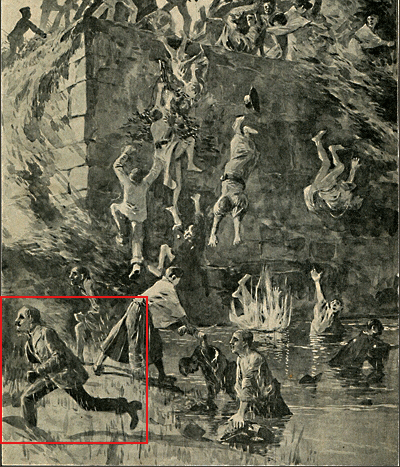 |
| |
The pages of The Tokyo Riot Graphic also suggest that one group—the women of the capital—although completely absent from the documentary trail of police and trial proceedings was nonetheless engaged with the issues of the day and present at rallies and even among the nighttime crowds watching the riotous action. It is important to note that taking part in these events was illegal for women even if they simply stood and watched. The 1889 “Law on Assembly and Political Societies” and the 1900 “Public Order Police Law” barred women from all forms of political life—not only voting, but joining political organizations, speaking at political meetings, and even attending such meetings.
Once in a while, it seems, they violated these laws and got away with it. A rare example was recorded by the Asahi on September 8, 1913, describing the rallies and the anti-government riot of the previous day sparked by a perceived weak response to the murder of a Japanese man in Nanjing. The formally scheduled rally took place in the center of Hibiya Park, but part of the overflow crowd converged on the bandstand at the park’s edge, creating an impromptu second site for speeches. Suddenly, “Ōno Umeyo, a believer in the Tenri religion and the 19-year-old eldest daughter of Ōno Shūsuke of the village of Tsukitate, Kurihara County, Miyagi Prefecture, ascended the bandstand. She wore a tight-sleeved summer kimono with a purple-blue skirt and had a hisashigami hair style. The crowd cheered and hooted: ‘Fantastic! Hurrah! A new woman!’ and so forth. She raised her voice: ‘Truly it is the duty of the Taishō woman to save our comrades in China.’ With her eloquent words she cut a brilliant figure.” [7]
The documentary record of the 1905 riot offers no written reference to any such female participation, but The Tokyo Riot Graphic’s illustrations indicate that women were informed and involved. Illustrating Yano’s account of the buildup to the rally is a woodcut of a vignette inside a streetcar. The fare collector is passing a row of riders. The caption reads “Distribution of Tens of Thousands of Leaflets Calling for a People’s Rally. Sept. 4.” Front and center among a representative cross section of Tokyoites in age, dress, and social type is a young woman closely reading the leaflet.
|
|
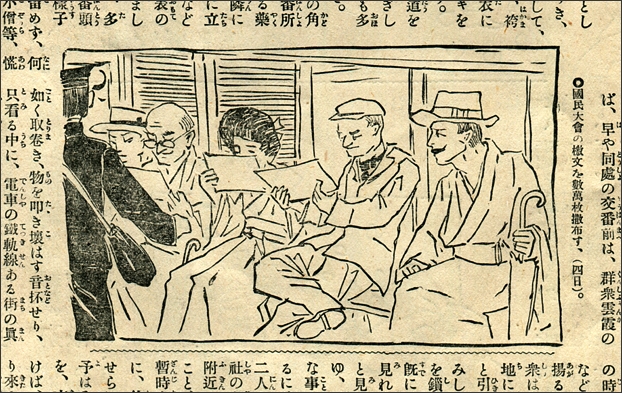 |
| |
A young woman joins male streetcar passengers reading a
September 4 leaflet announcing “a people’s rally.”
[trg028]
|
|
| |
Similarly, the banner across the cover of this special issue includes a young woman among the six people marching at an angle suggesting determination and perhaps haste. With Japanese flags in hand, these folks may be marching toward a rally site, or marching in one of the earlier wartime victory celebrations. The woman is dressed in the hakama skirt popular among the young women fortunate to attend one of Japan’s relatively few Girls Higher Schools at the time. Educated women in this artist’s conception were one element of the public engaged in the momentous events of the day.
|
|
| |
The stylized banner on the cover of The Tokyo Riot Graphic depicts individuals including a female student marching in haste to a rally. The military flags signify that they support the nation’s victory in the Russo-Japanese War, even while deploring the terms of the peace settlement.
[trg000]
|
|
| |
More subtly, some of the artistic illustrations in The Tokyo Riot Graphic also include women in the animated crowd scenes, where it requires careful scrutiny to single them out.
|
|
| |
Women in the Politicized Crowds
Although women were prohibited by law from engaging in political activities, they appear in some of the dramatic artistic renderings of crowds involved in the Hibiya Riot.
|
|
 
A kimono-clad woman in the crowd listening to an orator on the balcony of the Shintomiza theater on September 5.
[trg013] | 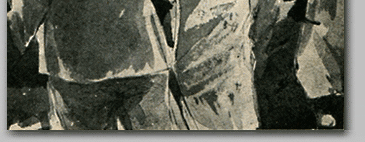 |
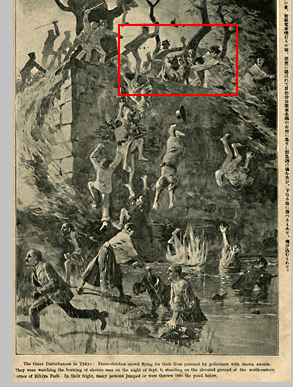 |
 
A woman in the panic-stricken crowd flees from police brandishing swords on September 6.
[trg021] |
| |
How reliable are these illustrations as a record of the day’s events? In contrast to the purported battlefield drawings and woodblock prints of both the Sino- and Russo-Japanese Wars, usually rendered from imagination at some distance from the battle front even when the artists were traveling with the troops, the illustrators of The Tokyo Riot Graphic observed the action first hand at close quarters. The offices of the Kinji Gahō were located in the center of Tokyo. Simply standing on the second floor balcony, it was possible for Kunikida and his colleagues, as they recalled, to “see fires here and there, flames rising from 15 or 16 different spots.” [8] (This is captured in the subtle color cover of the special issue.)
Even so, it is course the case that both photographs and drawings reflect choices of photographers and artists. The camera can mislead by omission. A photo editor can do so by cropping. Photographers can ask people to pose or to stage events. But a riot is not a time to easily stage pictures. Although we can never know whose picture was not taken or who was cropped out, we can be reasonably sure those who were captured in the photographer’s lens were present much as we see them.
In the case of hand-drawn illustrations, surely there was some exaggeration for dramatic effect in the depictions of crowds attacking buildings or fleeing the police. But we know from their own accounts that the Fudōsha artists were taught to value careful observation and accurate rendition. In the recollection of one student, the school’s founder, Koyama Shōtarō, enjoined him to “strive to render objects without an iota of difference, as if you had become a camera.” [9] Another student recalls “exhaustive” practice of pencil sketching, with a slightly different emphasis. Koyama told him to “look closely at nature, and draw more carefully, striving not so much for the minute detail of a photograph but for the simplicity that distills the essence of a scene based on careful observation and accurate rendition.” [10] Koyama perhaps tailored his emphasis to the particular needs of each student, but if the Tokyo Riot Graphic artists followed either version of his advice, they are hardly likely to have inserted figures of pure imagination into the scenes of riot as they pursued photographic accuracy or distilled the mood and rendered the essence of these events.
|
|
| |

|
|
|





